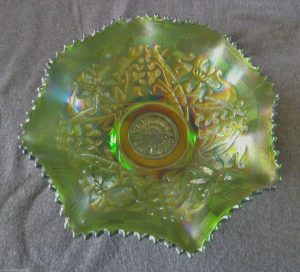How much does it cost? Prices are generally in the low to mid hundreds, though much of it is based on the pattern and piece. Some patterns like the Poppy Show design go for thousands, so the range is definitely wide in terms of price. Collectors Weekly says that carnival glass was often hand-finished by artisans, and those pieces tend to be more valuable than others.

What are some identifying features?
Patterns:The good news is that each glass company had different styles and designs the bad news is that few of them actually marked their creations with any type of manufacturer’s mark. The Field Guide to Carnival Glass has a lot of great resources for different patterns, shapes, and manufacturers, and the book Warman’s Carnival Glass: Identification and Price Guideis another solid resource.
Shape: The shape of an item can also be very telling is it a basket, bowl, candy dish, jar, or another shape? Greystone Publishing’s Carnival Price Guide has a helpful online tool that has photographs of different objects, so you can at least start with whatthe piece is candleholder, pitcher, etc. when trying to identify it.
Color: Each piece has a rainbow of colors, but there is always a specific “base color” that stands out. This can be helpful in identifying the pattern, so look at the base of the glass to see if it is a marigold, green, blue, or other hue that is prominent.
Base: The Carnival Glass Association offers this tidbit of advice look at the bottom of the base. Traditionally, the bottom was not made to look iridescent in older pieces but more modern pieces are often iridescent on all sides.
Though it might have been considered “cheap” in its day, carnival glass is definitely valuable today.

